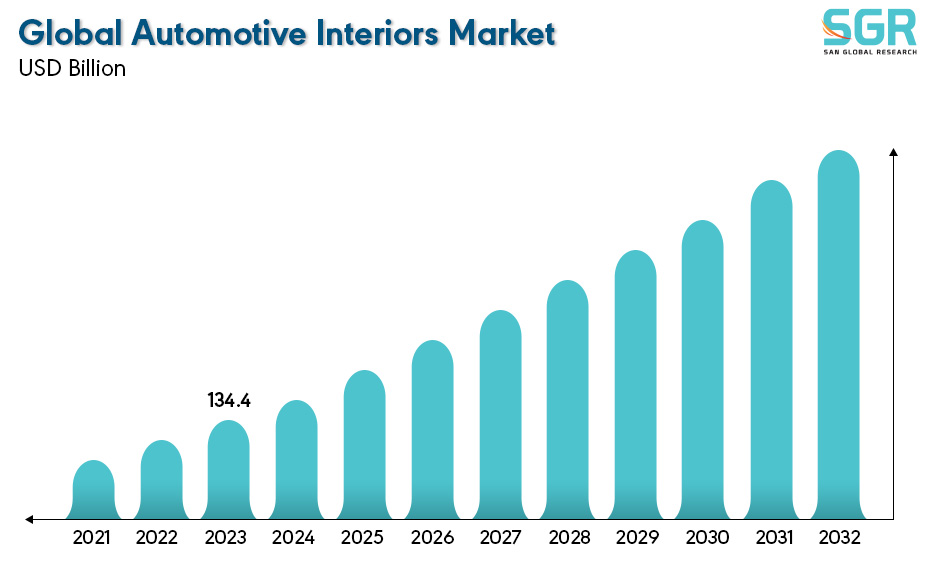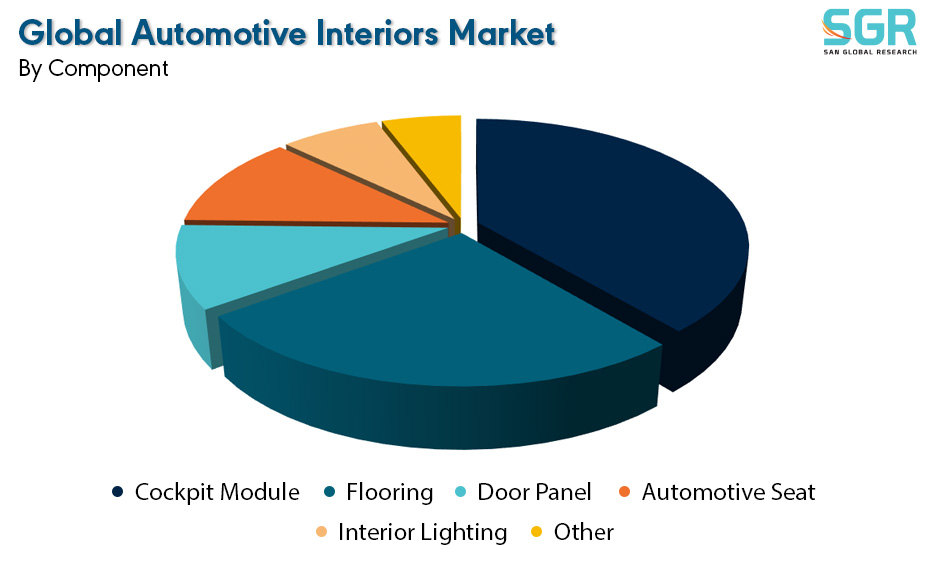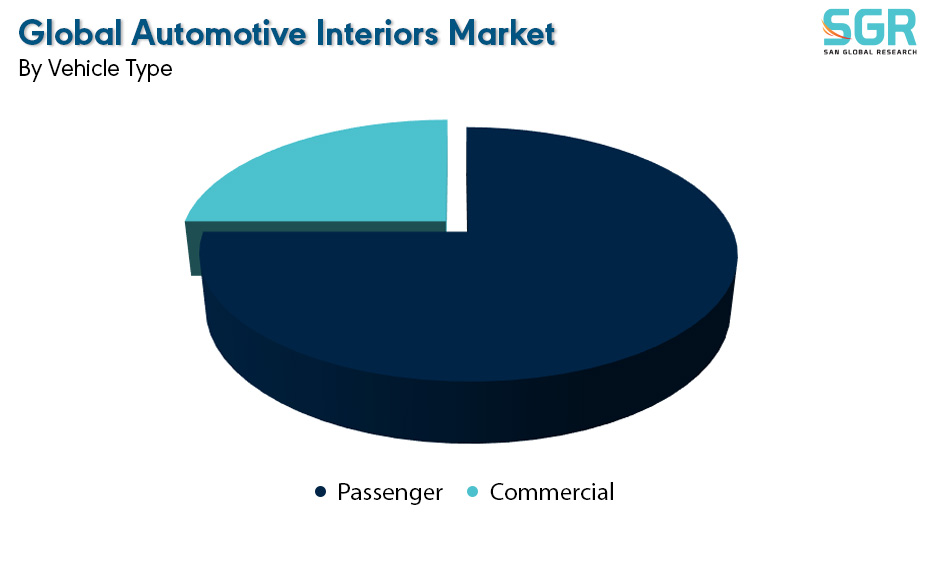Global Automotive Interiors Market is estimated to be worth USD 134.4 Billion in 2022 and is projected to grow at a CAGR of 4.3% between 2023 to 2032. The study has considered the base year as 2022, which estimates the market size of market and the forecast period is 2023 to 2032. The report analyzes and forecasts the market size, in terms of value (USD Billion), for the market. The report segments the market and forecasts it by component, by vehicle type and by region/country.

The global automotive interiors market represents a critical sector within the automotive industry, focusing on the design, functionality, comfort, and aesthetic appeal of vehicle interiors. Comprising various components such as dashboards, seating systems, upholstery, infotainment systems, consoles, and other interior elements, this market is driven by evolving consumer preferences, technological advancements, and stringent quality standards. Automakers constantly strive to enhance the overall driving experience by integrating cutting-edge technologies, advanced materials, and ergonomic designs into vehicle interiors. The shift towards connected and autonomous vehicles has further propelled innovation in automotive interiors, with a heightened emphasis on smart features, interactive displays, and integrated connectivity systems. Additionally, the growing focus on sustainability has led to the development of eco-friendly interior materials and manufacturing processes. Geographically, regions like Asia-Pacific, Europe, North America, and emerging markets in Latin America and Africa contribute significantly to this market's growth, each presenting unique opportunities and challenges influenced by varying consumer demands and regulatory landscapes. Overall, the global automotive interiors market continues to evolve, offering a diverse range of innovations aimed at enhancing comfort, safety, aesthetics, and technological integration within vehicle interiors.
.jpg)
Region wise Comparison:
North America boasts a significant share in the automotive interiors market due to its advanced automotive industry and consumer demand for high-quality interiors. Consumers in this region prioritize comfort, advanced infotainment systems, and innovative interior designs, leading to the incorporation of cutting-edge technologies in vehicles.
Europe stands as a prominent market for automotive interiors, characterized by a focus on luxury, comfort, and sustainability. European consumers lean towards premium interiors with high-quality materials, advanced safety features, and a strong emphasis on eco-friendly materials and manufacturing processes.
_Map.jpg)
This region showcases robust growth potential driven by the booming automotive industry in countries like China, Japan, India, and South Korea. Consumers here seek a balance between affordability, functionality, and technology. Rising disposable incomes have led to increased demand for comfortable, feature-rich interiors in vehicles across various segments.
Latin America contributes to the automotive interiors market, albeit with some variability across different countries. Economic fluctuations and varying consumer preferences impact the market dynamics. However, the increasing middle-class population in some countries fuels the demand for vehicles with better interiors.
These regions are experiencing a growing automotive market, with preferences varying based on economic conditions and cultural influences. While luxury features are popular in certain segments, there's also a demand for durable, easy-to-maintain interiors.
.jpg)
Segmentation:
The Global Automotive Interiors Market is segmented by component, by vehicle type and by region/country.
By Component:

Based on the component, the Global Automotive Interiors Market is bifurcated into Cockpit Module, Flooring, Door Panel, Automotive Seat, Interior Lighting, and Other– where Cockpit are dominating and ahead in terms of share.
The cockpit serves as the nerve center of a vehicle's interior and stands as a pivotal element within the global automotive interiors market. Evolving from a traditional control center to a sophisticated, multifunctional space, the modern cockpit integrates advanced technologies, user-friendly interfaces, and ergonomic designs to enhance the driver's experience. It encompasses the dashboard, instrument cluster, center console, infotainment systems, steering wheel, and other controls, offering a seamless blend of functionality, aesthetics, and connectivity. The rise of connected and autonomous vehicles has revolutionized cockpit design, introducing digital clusters, augmented reality displays, touch-sensitive surfaces, voice commands, and integrated connectivity features.
By Vehicle Type:

Based on the Vehicle Type, the Global Automotive Interiors Market is bifurcated into Passenger & Commercial – where Passengers is dominating and ahead in terms of share.
On the basis of region
• North America
• Europe
• Asia Pacific
• South America and
• Middle East and Africa
In 2022, North America is anticipated to dominate the Global Automotive Interiors Market with market revenue of XX USD Million with a registered CAGR of XX%.
Key Players:
The key market players operating in the Global Automotive Interiors Market include
• AKEBONO BRAKE INDUSTRY CO., LTD.
• VISTEON CORPORATION
• LEAR CORPORATION
• ROBERT BOSCH
• FAURECIA S.A
• YANFENG AUTOMOTIVE INTERIORS
• ADIENT
• CALSONIC KANSEI CORPORATION
• GRUPO ANTOLIN
• HYUNDAI MOBIS COMPANY, LTD.
• INTERNATIONAL AUTOMOTIVE COMPONENTS GROUP S.A. (IAC)
• NISSIN KOGYO Co., Ltd
Drivers:
Growing sector across the globe
The global automotive interiors market is propelled by a confluence of factors driving innovation, consumer demands, and technological advancements. One of the primary drivers is the ever-evolving consumer preferences, where buyers seek enhanced comfort, convenience, and personalized experiences within their vehicles. This demand pushes automakers and interior component manufacturers to continuously innovate, incorporating advanced materials, ergonomic designs, and cutting-edge technologies into vehicle interiors. Additionally, the surge in the adoption of connected and autonomous vehicles fuels the need for smart, technologically advanced interiors that integrate seamlessly with digital interfaces, infotainment systems, and in-car connectivity features. Furthermore, stringent regulations promoting safety and sustainability drive the development of eco-friendly materials and processes for automotive interiors. The market also responds to the growing focus on interior aesthetics, creating opportunities for luxury features and customizable options, catering to diverse consumer segments. These driving forces collectively shape the automotive interiors market, fostering a landscape of innovation and advancement to meet the dynamic demands of the automotive industry and consumers worldwide.
Opportunity:
Evolving Market
The global automotive interiors market presents a myriad of opportunities stemming from various trends and advancements within the automotive industry. One prominent opportunity lies in the integration of advanced technologies such as augmented reality (AR), artificial intelligence (AI), and smart sensors into vehicle interiors, enhancing the user experience and safety features. The shift towards electric and autonomous vehicles opens doors for innovative interior designs and configurations, as the focus pivots towards creating comfortable and versatile spaces for occupants. Furthermore, the growing emphasis on sustainability creates opportunities for the development of eco-friendly materials and manufacturing processes, meeting the rising demand for environmentally conscious interiors. Customization and personalization are emerging as key trends, providing opportunities for automakers and interior manufacturers to offer tailored interior solutions that cater to individual preferences and lifestyles. Moreover, the rise of shared mobility services prompts the creation of durable, easy-to-clean, and adaptable interiors that withstand high usage and diverse user needs. Overall, the global automotive interiors market is rife with opportunities driven by technological advancements, changing consumer preferences, and the evolving automotive landscape, fostering innovation and growth across the industry.
| Report Attribute | Details |
| Market Value in 2022 | 134.4 Billion |
| Forecast in 2032 | 432.8 Billion |
| CAGR | CAGR of 4.3% from 2024 to 2032 |
| Base Year of forecast | 2023 |
| Historical | 2019-2022 |
| Units | Revenue in USD Billion and CAGR from 2023 to 2032 |
| Report Coverage | Revenue forecast, Industry outlook, competitive landscape, growth factors, and trends |
| Segments Scope | By Component, By Vehicle Type |
| Regions Covered | North America, Europe, Asia Pacific, SA and MEA |
| Key Companies profiled | AKEBONO BRAKE INDUSTRY CO., LTD. VISTEON CORPORATION LEAR CORPORATION ROBERT BOSCH FAURECIA S.A YANFENG AUTOMOTIVE INTERIORS ADIENT CALSONIC KANSEI CORPORATION GRUPO ANTOLIN HYUNDAI MOBIS COMPANY, LTD. INTERNATIONAL AUTOMOTIVE COMPONENTS GROUP S.A. (IAC) NISSIN KOGYO Co., Ltd |

 Description
Description
 Table of Content
Table of Content
 Gera Imperium Rise,
Gera Imperium Rise,  +91 9209275355
+91 9209275355


